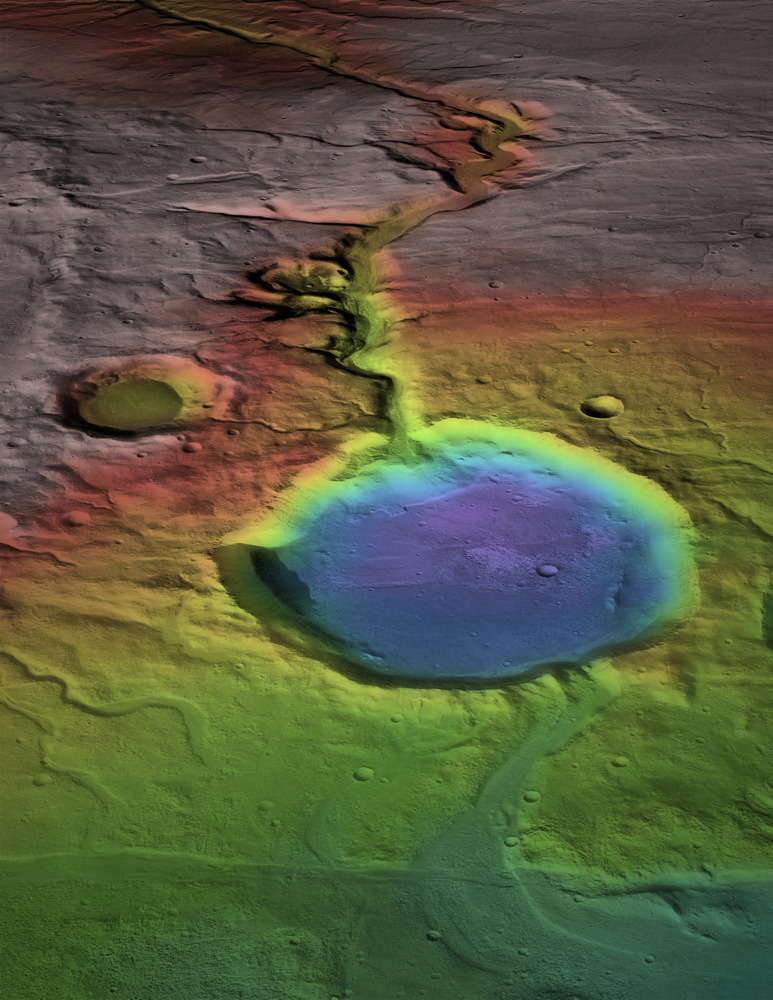Volcanic Eruptions on Mars Could Have Caused Water to Flow

Volcanic eruptions on Mars could have warmed that world, potentially helping solve the mystery of how water could have flowed across the surface of the Red Planet long ago, researchers say.
Although the surface of Mars is now cold and dry, there is ample evidence suggesting that rivers and lakes covered the Red Planet billions of years ago. However, the latest generation of climate models for early Mars suggests its atmosphere was too thin to keep the planet warm enough for water to flow. Moreover, the sun was much dimmer billions of years ago than it is now, suggesting Mars would have had less sunlight to heat it.
"The problem of explaining the evidence for liquid water on early Mars has defied attempts to solve it for a very long time," lead study author Itay Halevy, a planetary geochemist at the Weizmann Institute of Science in Rehovot, Israel, told Space.com. [Photos: The Search for Water on Mars]
Now, the researchers suggest intense volcanic activity could help solve this conundrum by regularly spewing tons of greenhouse gases into the Martian atmosphere that would have trapped heat. Each eruption would have kept Mars warm for decades or even centuries.
Many of the geological features that suggest water once flowed on Mars date to about 3.7 billion years ago, when massive volcanos were active. On Earth, widespread volcanism often leads to cooling rather than warming, because ash and sulfuric acid particles can reflect the sun's rays.
However, sulfuric acid may not have exerted as much of a cooling effect on Mars because the Martian atmosphere is dustier than Earth's. This dust normally reflects sunlight, helping keep the Red Planet cool. Sulfuric acid from volcanic eruptions would coat this dust, and while it would make it reflective, this combination would reflect less sunlight than would sulfuric acid and regular dust particles separately, researchers said.
In addition, the volcanoes would generate sulfur dioxide gas that would produce a significant greenhouse effect. The research team's computer models of the early Martian atmosphere suggest that, all in all, volcanic eruptions would heat the equatorial region of Mars enough for water to flow.
Get the Space.com Newsletter
Breaking space news, the latest updates on rocket launches, skywatching events and more!
"The reason that no prior work has seen similar effects is that no prior simulation of Mars' early climate included both dust and sulfuric acid," Halevy said.
This model of intermittent melting is consistent with previous evidence that channels and valley networks seen in ancient Martian terrain formed during temporary wet episodes.
"This model for Mars' early climate is like 'Brigadoon,' the Scottish village that appears for one day every hundred years," Halevy said. "For a few decades every several millennia, an eruption so large goes off that the atmosphere changes, the climate warms, the rivers flow and the lakes fill. Then, as the eruption dies off, things slowly relax back to their cold, icy, sleepy state for a few more millennia until the next biggie."
The climate on early Mars may have been very similar to that of the cold, desertlike McMurdo Dry Valleys in Antarctica.
"The average yearly temperature in the Antarctic Dry Valleys is way below freezing, but peak summer daytime temperatures can exceed the melting point of water, forming transient streams, which then refreeze," study co-author James Head at Brown University in Providence, Rhode Island, said in a statement. "In a similar manner, we find that volcanism can bring the temperature on early Mars above the melting point for decades to centuries, causing episodic periods of stream and lake formation."
This research might offer new clues about where the fossilized remnants of Mars life might be found, if it ever existed.
"Life in Antarctica, in the form of algal mats, is very resistant to extremely cold and dry conditions and simply waits for the episodic infusion of water to bloom and develop," Head said. "Thus, the ancient and currently dry and barren river and lake floors on Mars may harbor the remnants of similar primitive life if it ever occurred on Mars."
The scientists detailed their findings online Nov. 17 in the journal Nature Geoscience.
Follow us @Spacedotcom, Facebook or Google+. Originally published on Space.com.
Join our Space Forums to keep talking space on the latest missions, night sky and more! And if you have a news tip, correction or comment, let us know at: community@space.com.

Charles Q. Choi is a contributing writer for Space.com and Live Science. He covers all things human origins and astronomy as well as physics, animals and general science topics. Charles has a Master of Arts degree from the University of Missouri-Columbia, School of Journalism and a Bachelor of Arts degree from the University of South Florida. Charles has visited every continent on Earth, drinking rancid yak butter tea in Lhasa, snorkeling with sea lions in the Galapagos and even climbing an iceberg in Antarctica. Visit him at http://www.sciwriter.us











